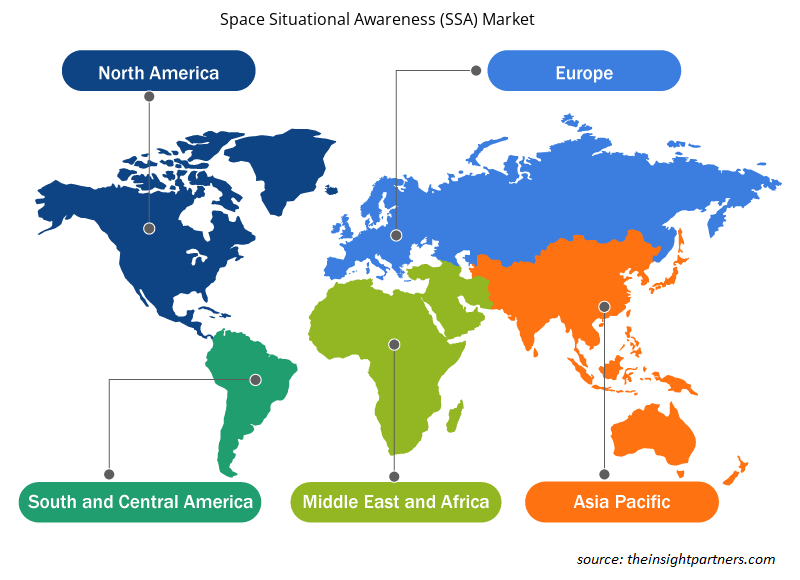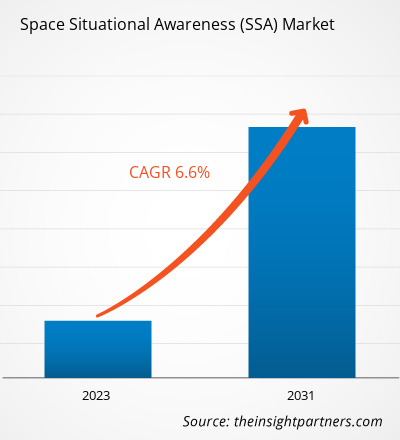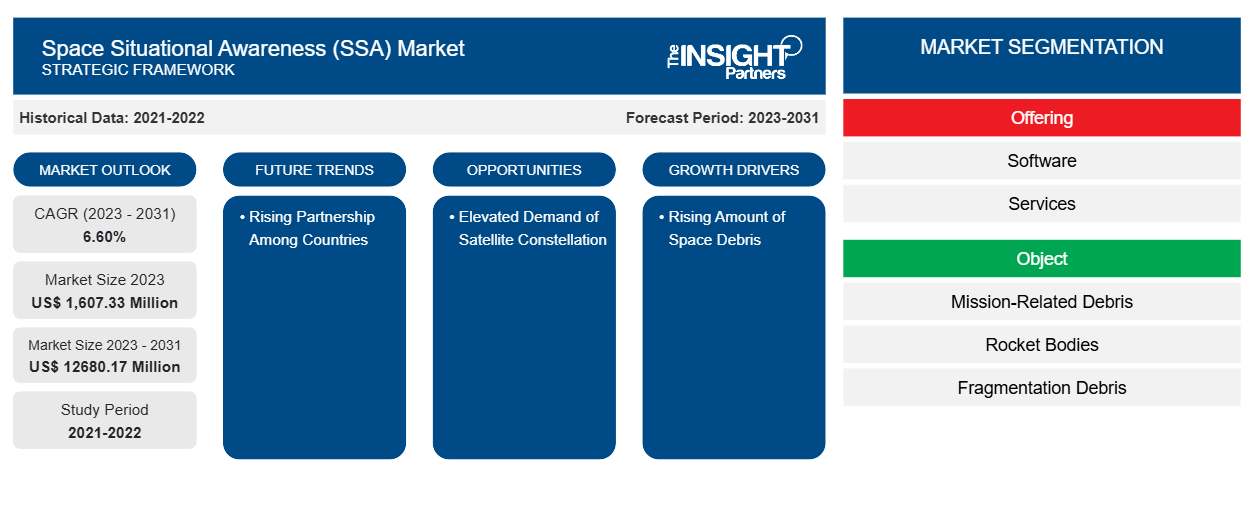Se proyecta que el tamaño del mercado de conocimiento de la situación espacial (SSA) alcance los 12680,17 millones de dólares estadounidenses para 2031 desde los 1607,33 millones de dólares estadounidenses en 2023. Se prevé que el mercado crezca a una CAGR del 6,60 % para 2031. El crecimiento del mercado de conocimiento de la situación espacial está impulsado por países con importantes organizaciones de exploración espacial, crecientes inversiones en investigación espacial y nuevos tipos de operaciones espaciales que generan nuevas amenazas para mantener información precisa sobre las órbitas de los objetos espaciales. Estados Unidos, Rusia, China, el Reino Unido, Japón y Francia son algunos de los principales países que operan la mayor cantidad de satélites en el espacio.
Análisis del mercado de la conciencia situacional espacial (SSA)
En 2022, se lanzaron al espacio sondas, satélites, naves espaciales tripuladas, módulos de aterrizaje y elementos de vuelo de estaciones espaciales para misiones de exploración interplanetaria con el fin de comprender mejor el cosmos. Según la Oficina de las Naciones Unidas para Asuntos del Espacio Ultraterrestre (UNOOSA), en 2022 se lanzaron al espacio 2.163 objetos, mientras que en 2021 y 2020 se lanzaron un total de 1.810 y 1.274 objetos, respectivamente. El número de lanzamientos de cohetes espaciales, principalmente para desplegar satélites en el espacio, también está aumentando rápidamente. En 2021, hubo 136 lanzamientos de cohetes con éxito, mientras que en 2022, el número aumentó a 180. En la primera mitad de 2022, las empresas con sede en Estados Unidos lanzaron 37 cohetes, de los cuales 27 fueron de SpaceX, 4 de RocketLab, 3 de United Launch Alliance y 1 de Astra, Northrop Grumman y Virgin Orbit. En el primer semestre de 2022, China, Rusia e India lanzaron 21, 9 y 2 cohetes, respectivamente. De los 21 lanzamientos de cohetes de China, el cohete Kuaizhou 1A desplegó un pequeño satélite de investigación llamado Tianxing 1 en una órbita polar de baja altitud a menos de 180 millas (290 km) sobre la Tierra. Nuevamente, en enero de 2023, China lanzó 14 satélites a bordo de un cohete portador Long March-2D desde el Centro de Lanzamiento de Satélites de Taiyuan en la provincia de Shanxi, en el norte de China. Los 14 satélites incluían Qilu-2 y Qilu-3, Luojia-3 01 y Jilin-1 Gaofen 03D34. En febrero de 2023, la Organización de Investigación Espacial de la India (ISRO) anunció el despliegue exitoso de tres satélites en sus órbitas previstas a través del vehículo SSLV-D2.
Descripción general del mercado de conocimiento de la situación espacial (SSA)
El conocimiento de la situación espacial (SSA, por sus siglas en inglés) es un componente vital del conocimiento del dominio espacial (SDA, por sus siglas en inglés) que ayuda a los encargados de tomar decisiones a comprender los entornos operativos actuales y previstos. El SSA rastrea e identifica objetos que ayudan a determinar sus órbitas, comprender su entorno funcional y pronosticar posiciones futuras y desafíos para sus operaciones. Además, el SSA ayuda a estimar los desechos de tormentas de meteoritos, eventos de fragmentación u otros posibles eventos naturales que pueden afectar las operaciones espaciales. El SSA es la base de todas las actividades de gestión del tráfico espacial (STM, por sus siglas en inglés) y seguridad espacial. Por lo tanto, todos estos beneficios del SSA impulsan su penetración.
Personalice este informe según sus necesidades
Obtendrá personalización en cualquier informe, sin cargo, incluidas partes de este informe o análisis a nivel de país, paquete de datos de Excel, así como también grandes ofertas y descuentos para empresas emergentes y universidades.
- Obtenga las principales tendencias clave del mercado de este informe.Esta muestra GRATUITA incluirá análisis de datos, desde tendencias del mercado hasta estimaciones y pronósticos.
Factores impulsores y oportunidades del mercado de conocimiento de la situación espacial (SSA)
Aumento de la cantidad de desechos espaciales
En 2021, Space Track informó de cuatro eventos de ruptura en órbita que generaron 150 fragmentos de escombros y dos eventos de colisión que produjeron 942 objetos, incluido el de la prueba ASAT rusa. Estos desechos espaciales en órbita amenazan a unos 3.000 satélites en funcionamiento actualmente en órbita, utilizados para comunicaciones críticas modernas y otros fines. Cualquier daño, incluso menor, a dichos activos espaciales puede tener impactos en cascada en muchos sistemas vitales, incluidos los de comunicación , transporte, programación horaria y aspectos críticos relacionados con la defensa. Muchas tecnologías de defensa de última generación, como misiles guiados, drones, recopilación de datos de inteligencia, comunicaciones cifradas y navegación, se verían limitadas o podrían volverse inoperantes con sistemas satelitales obsoletos. Por lo tanto, es crucial analizar el enfoque comparativo de todos los objetos espaciales para detectar amenazas de colisión con mucha antelación. La SSA se ocupa del conocimiento profundo del entorno espacial, la evaluación de cualquier amenaza a las actividades espaciales y la implementación de las medidas de mitigación necesarias para salvaguardar los activos espaciales funcionales. Por consiguiente, desempeña un papel crucial a la hora de garantizar la seguridad y la sostenibilidad de las actividades espaciales, de conformidad con las directrices, normas y demás normas nacionales e internacionales. Debido a la funcionalidad crítica de los sistemas de alerta temprana y a la creciente importancia de los satélites, el mercado de la conciencia situacional espacial se ve afectado positivamente por la creciente cantidad de desechos espaciales.
Creciente colaboración entre países
Los activos en el espacio están cobrando importancia para varios países, principalmente en lo que respecta a la seguridad nacional. El creciente interés en desplegar activos espaciales y garantizar su larga vida útil está dando lugar a varias asociaciones entre países. Dichas asociaciones abarcan varios aspectos de las misiones conjuntas relacionadas con el espacio y el intercambio de información, lo que, a su vez, se espera que ofrezca oportunidades de crecimiento prometedoras para el mercado de conocimiento de la situación espacial. En abril de 2022, India y Estados Unidos firmaron un nuevo acuerdo de SSA. Se espera que la asociación inicie nuevos intercambios espaciales de defensa entre el Comando Espacial de Estados Unidos y la Agencia Espacial de Defensa de la India. En diciembre de 2021, Australia y Corea del Sur firmaron un memorando de entendimiento (MoU) para colaborar en la exploración espacial, los servicios de lanzamiento y la navegación por satélite, así como para mejorar las capacidades de cada uno en SSA, observación de la Tierra, tráfico espacial y gestión de desechos. En noviembre de 2021, Japón y la India celebraron un diálogo espacial virtual para intercambiar información sobre la política espacial de cada país y debatir sobre seguridad espacial, cooperación bilateral entre la Agencia de Exploración Aeroespacial de Japón (JAXA) e ISRO, sus industrias espaciales, reglas y normas relacionadas con el espacio, sistemas globales de navegación por satélite, SSA y otras áreas de interés mutuo. En marzo de 2019, los gobiernos de Japón y Estados Unidos firmaron acuerdos para vincular los sistemas SSA de las Fuerzas de Autodefensa de Japón (SDF) y el ejército de Estados Unidos a partir del año fiscal 2023 para compartir información en tiempo real sobre satélites de terceros países y desechos espaciales , entre otros. Estas asociaciones y acuerdos entre varios países muestran la creciente importancia del espacio, los activos espaciales disponibles y la SSA entre los distintos gobiernos, lo que se espera que ofrezca amplias oportunidades de crecimiento para el mercado de conocimiento de la situación espacial en el futuro cercano.
Análisis de segmentación del informe de mercado de conciencia situacional espacial (SSA)
Los segmentos clave que contribuyeron a la derivación del análisis del mercado de conocimiento de la situación espacial (SSA) son la oferta, el objeto, el usuario final y el rango de órbita.
- Al ofrecer, el mercado de conocimiento de la situación espacial se bifurca en software y servicios. El segmento de servicios representó una mayor participación de mercado en 2023.
- Por objeto, el mercado de conocimiento de la situación espacial se segmenta en desechos relacionados con la misión, cuerpos de cohetes, desechos de fragmentación, naves espaciales funcionales y naves espaciales no funcionales. El segmento de desechos de fragmentación tuvo una mayor participación de mercado en 2023.
- Por usuario final, el mercado de conocimiento de la situación espacial se divide en comercial y gubernamental y militar. El segmento gubernamental y militar tuvo una mayor participación de mercado en 2023.
- En función del alcance de la órbita, el mercado de la conciencia situacional espacial se divide en el espacio profundo y el segmento cercano a la Tierra. El segmento cercano a la Tierra tuvo una mayor participación de mercado en 2023.
Análisis de la cuota de mercado de la conciencia situacional espacial (SSA) por geografía
El mercado global de conocimiento de la situación espacial (SSA) está ampliamente segmentado en América del Norte, Europa, Asia Pacífico (APAC) y el resto del mundo (RoW). Las crecientes amenazas de colisión de desechos orbitales con los activos espaciales operativos se han convertido en un problema perenne para el uso sostenible y seguro del espacio exterior. Estas amenazas restringen el acceso sin obstáculos al espacio y también obligan a las autoridades espaciales a tomar las medidas adecuadas para mitigarlas. El desarrollo de programas de conocimiento de la situación espacial (SSA) en los EE. UU. ayuda a monitorear varias amenazas de objetos creados por el hombre, que incluyen otros satélites, naves espaciales, armas antisatélites y desechos espaciales. SSA también ayuda a cumplir objetivos militares, que incluyen la preparación para operaciones defensivas y ofensivas, en los EE. UU.
El gobierno de los Estados Unidos, a través del Centro de Investigación de Conciencia Situacional Espacial (CSSAR), ofrece a los cadetes y al personal docente de la Academia de la Fuerza Aérea de los Estados Unidos un programa de educación e investigación en conciencia situacional espacial utilizando capacidades e instalaciones de clase mundial. El CSSAR también ayuda a proporcionar información sobre técnicas espectrales, fotométricas sin imágenes y polarimétricas, lo que conduce a la caracterización e identificación de objetos espaciales no resueltos. También ayuda en la fusión de fuentes de datos dispares, maximizando así la conciencia situacional y desarrollando aún más la capacidad de detección óptica. El CSSAR también ha desarrollado una red de telescopios de pequeña apertura que pueden ayudar a proporcionar cobertura global del catálogo espacial y mejorar la capacidad de observar satélites simultáneamente desde múltiples ubicaciones de telescopios para la investigación de fusión de datos.
Perspectivas regionales del mercado de conocimiento de la situación espacial (SSA)
Los analistas de Insight Partners explicaron en detalle las tendencias y los factores regionales que influyen en el mercado de conocimiento del entorno espacial (SSA) durante el período de pronóstico. Esta sección también analiza los segmentos y la geografía del mercado de conocimiento del entorno espacial (SSA) en América del Norte, Europa, Asia Pacífico, Oriente Medio y África, y América del Sur y Central.

- Obtenga datos regionales específicos para el mercado de conocimiento de la situación espacial (SSA)
Alcance del informe de mercado de conocimiento de la situación espacial (SSA)
| Atributo del informe | Detalles |
|---|---|
| Tamaño del mercado en 2023 | US$ 1.607,33 millones |
| Tamaño del mercado en 2031 | US$ 12680,17 millones |
| CAGR global (2023 - 2031) | 6,60% |
| Datos históricos | 2021-2022 |
| Período de pronóstico | 2023-2031 |
| Segmentos cubiertos | Al ofrecer
|
| Regiones y países cubiertos | América del norte
|
| Líderes del mercado y perfiles de empresas clave |
|
Densidad de actores del mercado de conocimiento de la situación espacial (SSA): comprensión de su impacto en la dinámica empresarial
El mercado de la conciencia situacional espacial (SSA) está creciendo rápidamente, impulsado por la creciente demanda de los usuarios finales debido a factores como la evolución de las preferencias de los consumidores, los avances tecnológicos y una mayor conciencia de los beneficios del producto. A medida que aumenta la demanda, las empresas amplían sus ofertas, innovan para satisfacer las necesidades de los consumidores y aprovechan las tendencias emergentes, lo que impulsa aún más el crecimiento del mercado.
La densidad de actores del mercado se refiere a la distribución de las empresas o firmas que operan dentro de un mercado o industria en particular. Indica cuántos competidores (actores del mercado) están presentes en un espacio de mercado determinado en relación con su tamaño o valor total de mercado.
Las principales empresas que operan en el mercado de conocimiento del entorno espacial (SSA) son:
- Gráficos analíticos, Inc.
- Soluciones exoanalíticas, Inc.
- Globvision Inc.
- GMV Soluciones Innovadoras SL
- Tecnologías L3Harris, Inc.
- Soluciones de seguridad y defensa de Kratos, Inc.
Descargo de responsabilidad : Las empresas enumeradas anteriormente no están clasificadas en ningún orden particular.

- Obtenga una descripción general de los principales actores clave del mercado de Conciencia situacional espacial (SSA)
Noticias y desarrollos recientes del mercado de conocimiento de la situación espacial (SSA)
El mercado de conocimiento de la situación espacial (SSA) se evalúa mediante la recopilación de datos cualitativos y cuantitativos posteriores a la investigación primaria y secundaria, que incluye publicaciones corporativas importantes, datos de asociaciones y bases de datos. A continuación, se incluye una lista de los avances en el mercado en materia de innovaciones, expansión comercial y estrategias:
- En abril de 2022, Ansys (NASDAQ:ANSS) Government Initiatives (AGI) apoyará a Northrop Grumman en el desarrollo, prueba y entrega de una capacidad de radar avanzada para el espacio profundo (DARC) en apoyo de la misión Space Domain Awareness del Comando de Sistemas Espaciales (SSC) de la Fuerza Espacial de los EE. UU. (USSF). (Fuente: Ansys, comunicado de prensa)
- En septiembre de 2022, ExoAnalytic Solutions prevé el regreso de Estados Unidos a la Luna a través de Artemis. Como parte de su apoyo al programa Air Force Blue Horizons Fellowship y a sus esfuerzos de seguimiento cislunar del Proyecto Rocket, la empresa está demostrando la aplicación de sus servicios de conocimiento del dominio espacial líderes en el mundo a la prueba de vuelo de Artemis I. (Fuente: ExoAnalytic Solutions, comunicado de prensa)
Informe de mercado sobre conciencia situacional espacial (SSA) y resultados finales
El informe “Tamaño y pronóstico del mercado de conocimiento de la situación espacial (SSA) (2021-2031)” proporciona un análisis detallado del mercado que cubre las siguientes áreas:
- Tamaño y pronóstico del mercado de conocimiento de la situación espacial (SSA) a nivel global, regional y nacional para todos los segmentos clave del mercado cubiertos bajo el alcance.
- Dinámica del mercado, como impulsores, restricciones y oportunidades clave
- Tendencias del mercado de conciencia situacional espacial (SSA)
- Análisis detallado de las cinco fuerzas de Porter y PEST y FODA
- Análisis del mercado de conciencia situacional espacial (SSA) que abarca las tendencias clave del mercado, el marco global y regional, los principales actores, las regulaciones y los desarrollos recientes del mercado
- Panorama del mercado de conocimiento de la situación espacial (SSA) y análisis de la competencia que cubre la concentración del mercado, el análisis de mapas de calor, los actores destacados y los desarrollos recientes.
- Perfiles detallados de empresas
- Análisis histórico (2 años), año base, pronóstico (7 años) con CAGR
- Análisis PEST y FODA
- Tamaño del mercado, valor/volumen: global, regional y nacional
- Industria y panorama competitivo
- Conjunto de datos de Excel
Informes recientes
Testimonios
Razón para comprar
- Toma de decisiones informada
- Comprensión de la dinámica del mercado
- Análisis competitivo
- Información sobre clientes
- Pronósticos del mercado
- Mitigación de riesgos
- Planificación estratégica
- Justificación de la inversión
- Identificación de mercados emergentes
- Mejora de las estrategias de marketing
- Impulso de la eficiencia operativa
- Alineación con las tendencias regulatorias























 Obtenga una muestra gratuita para - Mercado de Conciencia Situacional Espacial (SSA)
Obtenga una muestra gratuita para - Mercado de Conciencia Situacional Espacial (SSA)